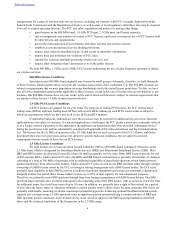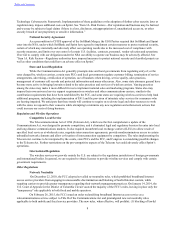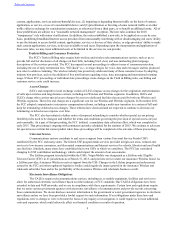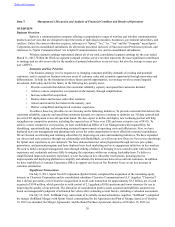Sprint - Nextel 2014 Annual Report Download - page 18
Download and view the complete annual report
Please find page 18 of the 2014 Sprint - Nextel annual report below. You can navigate through the pages in the report by either clicking on the pages listed below, or by using the keyword search tool below to find specific information within the annual report.
Table of Contents
16
The FCC recently revised its transactional “spectrum screen” that it uses to identify prospective wireless
transactions that may require additional competitive scrutiny. If a proposed transaction would exceed the spectrum screen
threshold, the FCC undertakes a more detailed analysis of relevant market conditions in the impacted geographic areas to
determine whether the transaction would reduce competition without offsetting public benefits. The revised screen now
includes substantial portions of the 2.5 GHz band previously excluded from the screen and that are licensed or leased to
Sprint in numerous markets. As a result, future Sprint spectrum acquisitions may exceed the spectrum screen trigger for
additional FCC review. Such additional review could extend the duration of the regulatory review process and there can be no
assurance that such transactions will ultimately be completed in whole or in part.
The FCC and other federal agencies have recently engaged in increased regulatory and enforcement activity as
well as investigations of the industry generally. Depending upon their interpretation, newly adopted net neutrality regulations
may have unforeseen consequences for our business. Such regulations, enforcement activities, or investigations could make it
more difficult and expensive to operate our business, and could increase the costs of our wireless operations. In addition, we
may offer products that include highly regulated financial services, which subject us to additional state and federal
regulations. The costs to comply with such regulations and failure to remain compliant with such regulations could adversely
affect our results of operations.
Degradation in network performance caused by compliance with government regulation, loss of spectrum, or
additional rules associated with the use of spectrum in any market could result in an inability to attract new subscribers or
higher subscriber churn in that market, which could adversely affect our revenues and results of operations. Furthermore,
additional costs or fees imposed by governmental regulation could adversely affect our revenues, future growth, and results
of operations.
Competition, industry consolidation, and technological changes in the market for wireless services could negatively affect
our operations, resulting in adverse effects on our revenues, cash flows, growth, and profitability.
We compete with a number of other wireless service providers in each of the markets in which we provide
wireless services. Competition is expected to continue to increase as additional spectrum is made available for commercial
wireless services, and we expect an increased customer demand for data usage on our network. Competition in pricing,
service, and product offerings may adversely impact subscriber retention and our ability to attract new subscribers. A decline
in the average revenue per subscriber coupled with a decline in the number of subscribers would negatively impact our
revenues, cash flows, and profitability. In addition, consolidation by our competitors and roaming partners could lead to
fewer companies controlling access to network infrastructure, enabling our competitors to control usage and rates, which
could negatively affect our revenues and profitability.
The wireless communications industry continues to experience significant technological change, including
improvements in the capacity, quality, and types of technology. These developments cause uncertainty about future subscriber
demand for our wireless services and the prices that we will be able to charge for these services. As services, technology, and
devices evolve, we also expect continued pressure on voice, text, and other service revenues. Rapid changes in technology
may lead to the development of wireless communications technologies, products, or alternative services that are superior to
our technologies, products, or services, or that consumers prefer over ours. In addition, technological advances have caused
long distance, local, wireless, video, and Internet services to become more integrated, which has contributed to increased
competition, new competitors, new products, and the expansion of services offered by our competitors in each of these
markets. If we are unable to meet future advances in competing technologies on a timely basis, or at an acceptable cost, we
may not be able to compete effectively and could lose subscribers to our competitors.
The trading price of our common stock has been, and may continue to be, volatile and may not reflect our actual
operations and performance.
Market and industry factors may adversely impact the market price of our common stock, regardless of our actual
operations and performance. Stock price volatility and sustained decreases in our share price could subject our stockholders
to losses and may adversely impact our ability to issue equity. The trading price of our common stock has been, and may
continue to be, subject to fluctuations in response to various factors, some of which are beyond our control, including, but not
limited to:
• quarterly earnings announcements and variations in our results of operations or those of our competitors;
• market and pricing risks due to concentrated ownership of our stock;
• the issuance of additional debt or equity, the cost and availability or perceived availability of additional
capital;
























